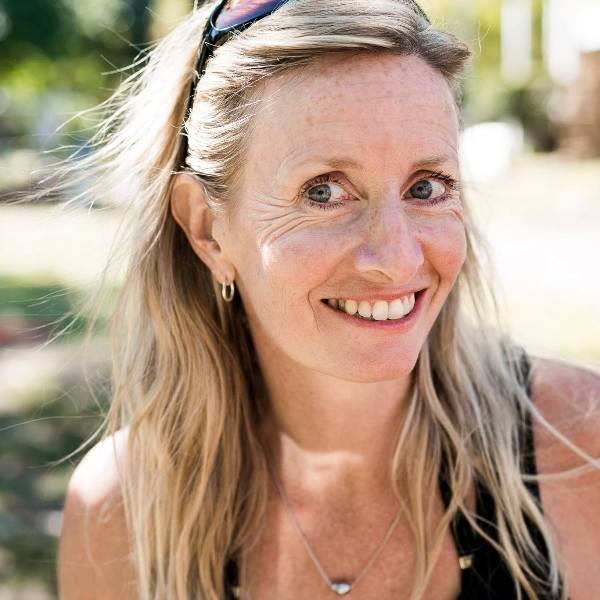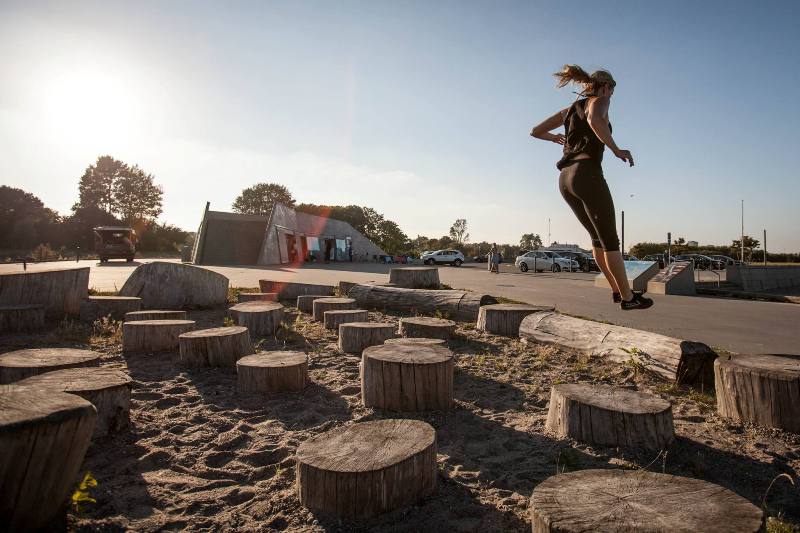
Dr. Julie Angel did her PhD thesis on parkour. I didn’t know you could do PhD theses on things like parkour, but she did it. Oh, and she can jump. Pretty good at it, too, from what I hear.
After living a sedentary lifestyle for twenty years, Julie found parkour and fell in love with movement. Twelve years later and now in her late 40s, she’s a veteran of both parkour and MovNat, among other movement practices. Julie trains with a group of women in their 40s, 50s, and 60s, which is probably not the first demographic you’d associate with parkour (more on that later).
When Julie is not moving, she makes films, does photography, and other creative projects.
In her own words…
I create work I like, for, or about, people and companies that I like. I spend a lot of time documenting the current ‘age of athletisiscm ‘ – Parkour, MovNat, buildering and much more. Films, photography, action promos, research, writing and presentations. Anything but drama. Filming and understanding what people do so I can share their vision and stories to inspire others.
I first learned about Julie’s work when I watched this mini-documentary series on MovNat. I also saw that she did some work with Christopher McDougall (the author of the best-seller, Born To Run – recommended!) while on tour for his latest book, Natural Born Heroes: Mastering the Lost Secrets of Strength and Endurance (also recommended!).
Julie has also done some writing of her own. She is the author of Breaking The Jump: The Secret Story of Parkour’s High-Flying Rebellion.
And most recently, she’s also the founder of See & Do, where she hosts Strong Body Strong Mind workshops and courses. Needless to say, Julie wears many hats – with movement being the common theme.
Here is one of Julie’s short films on parkour…
Note: there are many more great films on Julie’s Youtube channel.
Interview with Julie Angel
The number one takeaway I got from this interview is that parkour isn’t what you think it is. There is so much more. So, if you’re looking for a surface-level discussion about the nuts and bolts of parkour, this isn’t the interview for you. But if you’re looking for something much deeper, you’re in for a treat because Julie shared many high-level ideas. The best part? She explained them in ways that even I can understand.
And Julie shared a lot in this one-hour call, going deep right from the beginning. And by the way, you don’t have to be into parkour to enjoy and benefit from this interview. Anyone interested in health, fitness, training, or personal development will find this to be a fascinating discussion.
Here are some of the topics we discussed…
- What Julie’s life was like before she found parkour and how she got started with it after 20 years of sedentary living (including the story of Julie’s first parkour class and how it completely destroyed her physically. Plus, a cramped car experience with elite parkour athletes who had legs like “bricks.”)
- What it was like to follow the original group of parkour traceurs who started this movement
- How Julie went from hating running, not being able to do a pullup, and being “skinny fat” to running up walls, doing pull-ups with ease, and vaulting, among other high level skills.
- How Julie got her PhD in parkour, blazing a trail for others to follow in her footsteps – and what that experience taught her
- What appealed to Julie about parkour moreso than buildering, urban golf, and other movement practices
- The difference between the spectacle of parkour (i.e. what spectators see and think about it) and how traceurs actually live, think, and train on a daily basis
- The power of overcoming obstacles and what changes when you do regularly
- Why parkour is so much more than just moving from point A to point B
- The rarely mentioned benefits of movement that keep parkour veterans motivated for decades
- The skillsets necessary to train parkour hard for decades and not get injured or broken
- Why training your mind is just as important as training your body (and how to do it)
- How parkour is a “reveal and heal” system
- Training parkour in the city versus in nature versus indoors
- How you can be strong, healthy, and able in your 40s, 50s, 60s, and beyond
- Why you shouldn’t doubt anyone’s ability and how almost anyone can learn how to run up a wall with a few key techniques
- Why you need to make people comfortable to get them out of their comfort zone
- How to change the world by changing your relationship with your environment
- The dietary changes Julie made that tripled her strength and drastically improved her energy levels
- How parkour is a “culture of effort” – both physically and internally
- How to get physically strong in a fun and practical way
- How to use fear to train your emotional resiliency
- What really matters at the end of the day…after 12 years of training
- How the language we use impacts our success
- Several of the best ways to get started with parkour
- And much more!
So, if you’re at all interested in parkour, movement, or the transformative power of training, in general, check out this interview with Julie Angel. I hope you enjoy it as much as I did.
Get ready for a barrage of truth bombs!
Interview with Julie Angel – M4A AUDIO FILE (58 minutes, 81 MB).
Wrap Up
I want to thank Julie again for taking the time to do this interview. It was a pleasure to hear your story and chat about parkour for a bit. And I’m looking forward to doing it again soon.
You can learn more about Julie and her work at her websites: www.JulieAngel.com and www.See-Do.com. And you can check out her book here: Breaking The Jump: The Secret Story of Parkour’s High-Flying Rebellion.

If you found this article helpful, please share it with your friends:
.jpg)
![]()
Health-First Fitness Coach
P.S. If you liked this post, then please signup for the newsletter, or follow me on Facebook or Twitter for daily updates and other interesting info.
